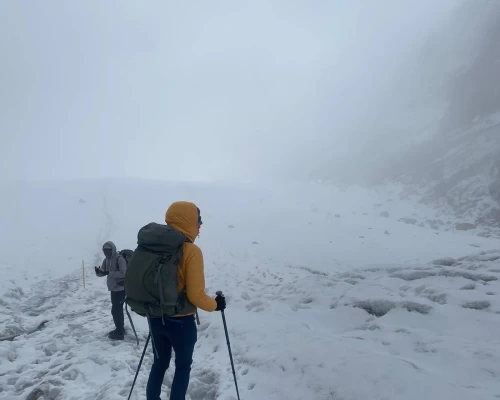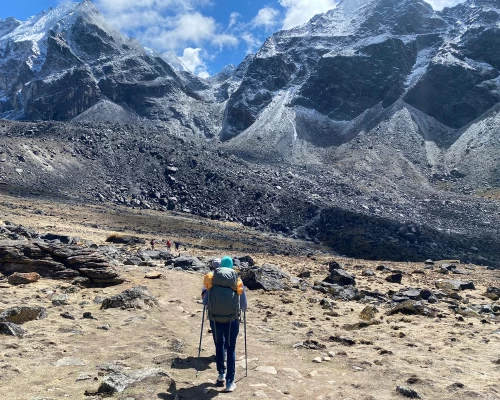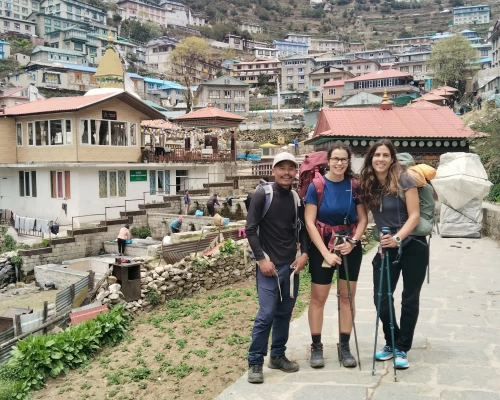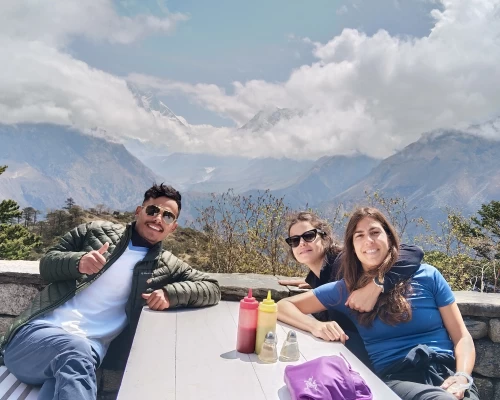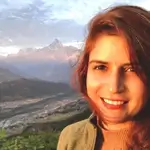DIFFICULTY LEVEL OF GOKYO CHO LA PASS TREK
The Gokyo Chola Pass Trek is matched for trekkers of differing capabilities, from beginners to seasoned trekkers. It's taken into consideration modest hiking in Nepal, with steady increases in altitude together and well-kept trails. However, the journey involves 5-6 hours of hiking each day over challenging terrain, so being in good physical shape is important. Regular exercise, like walking and aerobics, can help build stamina for the trek, especially since higher altitudes have less oxygen, making it tougher to adjust.
The highest point of the trek is at Chola Pass, reaching around 5,420 meters above sea level. Trek days are prepared with shorter distances to ensure trekkers’ health and comfort. Rest breaks at teahouses along the way help alleviate fatigue and stress. There’s a danger of Acute Mountain Sickness (AMS) due to the high altitude, so precautions for altitude safety are crucial. Even though the risk of AMS is lower, maintaining good health is still important to avoid any complications. While it’s possible to trek alone, it’s not recommended, as being alone in the mountains can be challenging in case of emergencies.
The ascent to High passes are the most challenging part of the trek, but the breathtaking views from the Gokyo Chola Pass viewpoints make the effort worthwhile, providing trekkers with a memorable experience amidst the stunning Himalayan scenery.
BEST SEASON OF GOKYO CHOLA PASS TREK
Autumn, from September to November, stands out as the prime time for trekking the Gokyo Chola Pass route. This period sees clear skies after the monsoon rainfall offering spectacular sights of the mountains surrounding scenery. The weather is mild and pleasant, with very little rain, making it perfect for trekking experiences. Spring, from March to May, rates as the second-best time for discovering the Gokyo Chola Pass. Throughout this duration lively blossoms like rhododendrons blossom, creating a colorful backdrop for trekkers.
On the other hand, the summer season from June to August, brings warm temperature levels as well as constant rainfall plus rainstorms, making trekking conditions challenging as well as muddy. Fewer individuals trek throughout this time providing a quieter experience however the trails can be unsafe and also dangerous. On the other hand, the winter months from December to February see most trails covered in snow, with cold and completely dry weather conditions dominating. Hefty snow loss along with avalanches might shut hill passes, making winter months hiking much less prominent. Heavy snowfall and avalanches may close mountain passes, making winter trekking less popular. However, the snow-capped landscapes offer a unique and picturesque sight for those willing to brave the cold.
ACCOMMODATIONS AND MEALS DURING GOKYO CHOLA PASS TREK
During your trek, food and accommodation are taken care of at guest or tea houses, which are traditional Sherpa houses serving authentic local cuisine. The lodges are basic and can be cold, so it’s essential to bring warm clothing. As you ascend, prices for accommodation and food increase, while quality may decrease. Extras like hot showers, charging electronics, and Wi-Fi come at an additional cost.
During peak trekking seasons, finding a room, especially a single one, can be challenging as they’re often booked in advance. It’s advisable to ask your guide or porter to make reservations or be prepared to share a room with other guests. Meals offer a variety of options, from local Nepali cuisine like Dal Bhat Tarkari (Lentil soup, Rice, and Vegetable) to Chinese cuisines like Momos (dumplings) and Chow Mein. Also, International options like pizza, sandwiches, and sizzlers are available. Additionally, beverages like tea, coffee, fruit juice, and alcoholic drinks can be purchased for an extra charge.
GOKYO CHOLA PASS WITH EBC TREK COSTS
For the Gokyo Chola Pass Trek, the total cost typically ranges from $1500 to $1800 per person. Upon arrival at Tribhuvan International Airport, you’ll need to purchase a Nepal Visa, which varies depending on the duration of your stay. However, it is suitable that you acquire a Visa for 30 days which costs you $50 per person. Your trip commences with a domestic flight from Kathmandu to Lukla (one of the most dangerous airports in the world) and ends with a domestic flight to Kathmandu. A flight from Kathmandu to Lukla can cost you anywhere between USD 440.00 per person. On the contrary, it can be quite expensive on your return.
Hereby, your tour options, hotel accommodations, and mode of transportation all impact the cost of the trek. Your budget, choice between normal and deluxe trip plans, and the size of your group will also influence the overall price.
What to Pack for Gokyo Chola Pass Trek?
- Headlamp or Flashlight with extra batteries as teahouses charge you for charging your electronics.
- Pack a backpack that is preferably waterproof
- Water filter: Any water filter will suffice because there are numerous water taps along the route where you can refill your water, and it is also environmentally friendly.
- Sturdy and waterproof boots
- Sunglasses, sunscreen, and lip balm with SPF
- Shampoo and soap: If the lodge does not provide these, bring your own.
- Thermal Layer
- Towel, Personal toiletries, and medications
- Camera and Portable Charger
- Insect repellent
- Sleeping Bag suitable for cold temperatures.
- Hiking Poles: Helps to maintain the ascent while traversing high terrain.
- Windproof mittens: This would keep chilly hands from freezing and make high-altitude viewing sites more enjoyable.
- Water bottle that can be refilled
- If you’re traveling during the monsoon, don’t forget to bring your rain gear.

